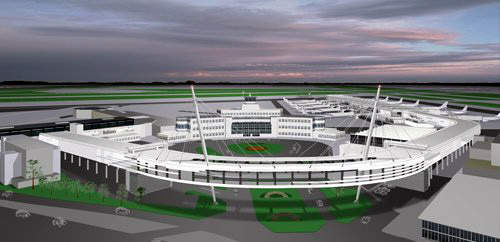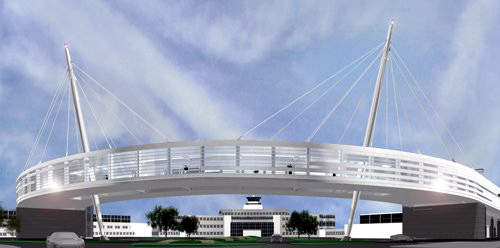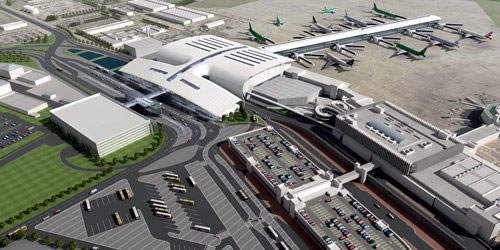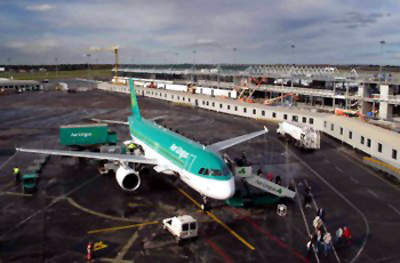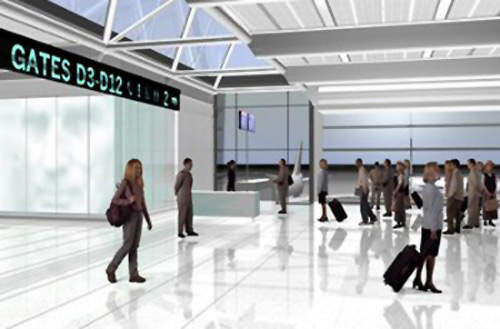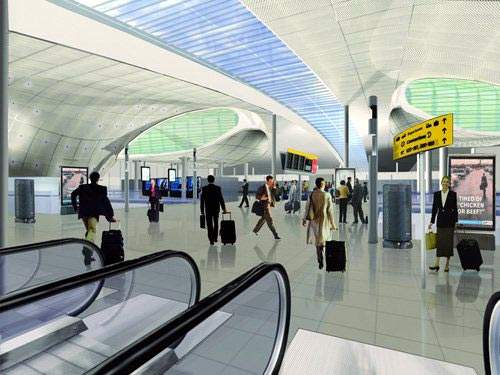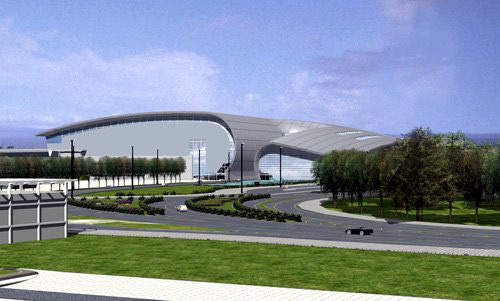In October 2006, Dublin Airport received planning permission to build a new multi-million-euro terminal. Fingal County Council gave airport officials authorisation to begin work on what will be the airport’s second terminal, capable of handling with 15 million passengers a year.
Dublin Airport Authority (DAA) began the process of gaining planning permission for the new terminal in July 2005. The programme was part of a €2bn development plan (ten-year capital investment programme) for Dublin Airport being undertaken in the period up to 2020 (Transforming Dublin Airport programme).
Construction of the $820m terminal began in mid-2007 and was completed in November 2010. Dublin Airport now has a capacity of 35 million passengers a year and an extra 20 aircraft boarding gates (50% increase in size).
Planning
In 2004, Aer Rianta appointed PM (project management) Group to prepare a master plan for Dublin International Airport for the period up until 2020. Passenger numbers are expected to increase from the 2002 level of 15 million a year to 30 million a year by 2020.
In 2009 Dublin airport handled 20.5 million passengers. For the ‘terminal expansion 2020’ master plan PM led an international planning team that included US architects Skidmore Owings & Merrill (SOM), UK aviation consultants TPS Consult and RPS Group.
The study started with an analysis of the baseline capacities and service capabilities of the existing facilities and infrastructure. The next phase involved developing various approaches to land-use that generated 31 high-level options.
Following an extensive evaluation process, four options were short-listed and ranked in terms of functionality, deliverability and cost. A preferred option was selected on the basis of the ranking process.
All stages of the process involved inclusive and transparent consultation with a wide range of stakeholders. The preferred option was a second terminal (incorporating pier E) and a new pier development (D).
Development
The pier D development was the first stage in a €2bn capital investment programme at the airport. PM Group is leading the design team for the programme, which will transform the airport over the next ten years in response to the huge growth in both passenger numbers and freight growth at the airport.
Construction work on the new pier D was completed in autumn 2007. The two-storey, 15,000m³ pier has 12 gates serving 14 new aircraft contact stands 257m-long and 29m-wide. It has separate arrivals and departure areas and the capacity to cater for ten million passengers per annum; the pier also has three dedicated retail and restaurant facilities.
PM was responsible for the project management of a multi-disciplinary team including architectural and aviation planning sub-consultants. PM also provided mechanical, electrical, IT, civil and structural engineering, procurement services and cost management via sub-consultants. The UK-based international construction firm, Laing O’ Rourke was appointed to build pier D.
Terminals
A consortium comprising Ové Arup, Pascall & Watson and Mace was appointed as project managers and designers for the 75,000m³ terminal two, pier E and all the associated kerbside integration works needed to link the new passenger terminal with the existing terminal one.
The quantity surveying and cost consultancy firm, Davis Langdon PKS was appointed as cost consultant for the new terminal, pier E and kerbside works. Turner & Townsend, the Leeds-based international construction and management consultancy firm, were appointed as external programme managers to integrate the new terminal with the original one (a total of over 120 projects).
T2 is served by its own dedicated arrivals and departures roads and comprises a check-in hall and a departures hall connected by a bridge that forms the central spine of the building.
The new terminal has 58 check-in desks and ample provision for self-service and online check-in and baggage drop. Beyond an enlarged security screening area, passengers enter a departures lounge with shops. A new facility allows transatlantic passengers to clear US customs and border protection before departure.
In total, T2 has 9,000m² of retail and catering outlets. The revenue from these outlets and other commercial income such as car parking fees will help minimise passenger charges at Dublin Airport.
The Terminal 2 development project also included construction of a power plant and an upgrade of the road network within the airport premises.
Pier construction
Extending over 200m on to the airfield apron at the northern edge of the airport, pier D provides significant new passenger boarding capacity and 14 new aircraft contact stands.
These facilitate direct boarding and disembarkation of passengers and enable highly efficient turnaround of aircraft schedules.
The second passenger terminal was built on a site adjacent to the existing terminal and incorporating the existing pier C. It was designed to handle up to 15 million passengers and to cater for the requirements of long-haul and short-haul aviation traffic and for the transfer of passengers and baggage between both modes.
A second new satellite pier, pier E, extends at right angles on to the airfield apron from the new terminal and provides additional new wide-bodied and narrow-bodied aircraft contact stands as Dublin Airport’s passenger traffic continues to grow.
Both the new terminal and pier E were opened in November 2010. T2 is a three-storey curvilinear building that will sit astride the main access road to terminal one.
Upgrade
In December 2005 a €54 million upgrade to terminal one was planned. The 7,500m² extension is located at the north-western corner of terminal one.
In February 2008, the new Terminal 1 extension was granted planning permission by An Bord Pleanála. The extension was completed and opened in April 2009 as per schedule. The new Terminal 1 extension was designed to get rid of bottlenecks at the airport and to integrate the terminal with piers A and D to give a better passenger experience.
The existing check-in area, area 13, at the northwestern end of the terminal was reconfigured and the extension created a larger airside circulation area for passengers en route to piers A and D, featuring 25 new check-in desks and a capacity for four million passengers a year. The extension consisted of arrivals and departures facilities on two levels, with support accommodation, including additional check-in desks, retail, a restaurant and bar on the mezzanine level, catering, storage, service and plant utilities.
The civil and structural engineering works were taken up by RPS Group, including the outline design of a 700t structural steel frame supported on concrete foundations, the engineering for the fitted glazed façade and the utility services diversions / reinstatement for the airside compound. RPS also carried out the fire strategy and engineering for the terminal extension building.
Runways
Investment in a new runway at Dublin Airport is needed to meet the ever-increasing demand for travel to and from Ireland. In December 2004, DAA submitted a planning application to Fingal County Council for a new parallel runway, which allows the airport to accommodate over 50 million passengers a year.
The length of the proposed runway is 3,660m. This length is based on consultation with the users and with minimising the impact of the construction on the surrounding road network. The horizontal separation between the two runways will be 1,690.6m (1km). The width of the runway will be 60m with 7.5m shoulders either side.
In December 2008, DAA announced its decision to postpone the construction of the new runway to 2011-2012. The decision was taken due to the anticipated decrease in air travel demand and need to reduce costs.
The new runway was expected to replace runway 11/29. Runway 11/29, the shortest runway at Dublin Airport, was decommissioned and is being used to park aircraft.
Runway 16/34 remains in service and is used primarily for cross-wind operations. Runway 10/28, the existing main runway (opened in 1989) will operate independently of the new runway.
Other projects
A €3m dedicated coach and bus park was built at the rear of the multistorey car park, delivering upgraded transit and parking facilities for the bulk of the 700 buses that use the airport daily.
In tandem with this project, the short-term car park control system was revamped and upgraded and a new improved parking zone was created for disabled passengers.

